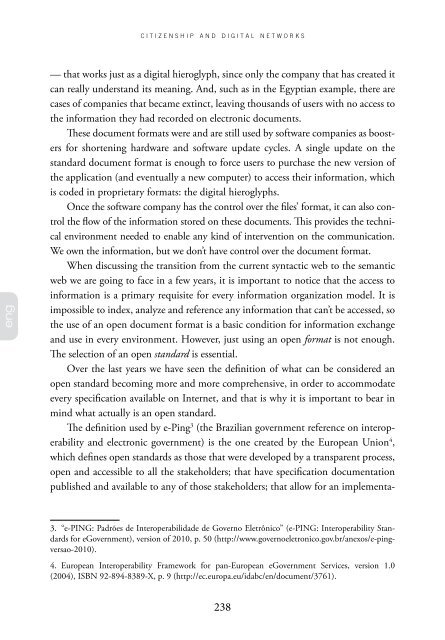Sergio Amadeu da Silveira - Cidadania e Redes Digitais
Sergio Amadeu da Silveira - Cidadania e Redes Digitais
Sergio Amadeu da Silveira - Cidadania e Redes Digitais
You also want an ePaper? Increase the reach of your titles
YUMPU automatically turns print PDFs into web optimized ePapers that Google loves.
eng<br />
c i t i z e n s h i p a n d d i g i t a l n e t w o r k s<br />
— that works just as a digital hieroglyph, since only the company that has created it<br />
can really understand its meaning. And, such as in the Egyptian example, there are<br />
cases of companies that became extinct, leaving thousands of users with no access to<br />
the information they had recorded on electronic documents.<br />
These document formats were and are still used by software companies as boosters<br />
for shortening hardware and software up<strong>da</strong>te cycles. A single up<strong>da</strong>te on the<br />
stan<strong>da</strong>rd document format is enough to force users to purchase the new version of<br />
the application (and eventually a new computer) to access their information, which<br />
is coded in proprietary formats: the digital hieroglyphs.<br />
Once the software company has the control over the files’ format, it can also control<br />
the flow of the information stored on these documents. This provides the technical<br />
environment needed to enable any kind of intervention on the communication.<br />
We own the information, but we don’t have control over the document format.<br />
When discussing the transition from the current syntactic web to the semantic<br />
web we are going to face in a few years, it is important to notice that the access to<br />
information is a primary requisite for every information organization model. It is<br />
impossible to index, analyze and reference any information that can’t be accessed, so<br />
the use of an open document format is a basic condition for information exchange<br />
and use in every environment. However, just using an open format is not enough.<br />
The selection of an open stan<strong>da</strong>rd is essential.<br />
Over the last years we have seen the definition of what can be considered an<br />
open stan<strong>da</strong>rd becoming more and more comprehensive, in order to accommo<strong>da</strong>te<br />
every specification available on Internet, and that is why it is important to bear in<br />
mind what actually is an open stan<strong>da</strong>rd.<br />
The definition used by e-Ping 3 (the Brazilian government reference on interoperability<br />
and electronic government) is the one created by the European Union 4 ,<br />
which defines open stan<strong>da</strong>rds as those that were developed by a transparent process,<br />
open and accessible to all the stakeholders; that have specification documentation<br />
published and available to any of those stakeholders; that allow for an implementa-<br />
3. “e-PING: Padrões de Interoperabili<strong>da</strong>de de Governo Eletrônico” (e-PING: Interoperability Stan<strong>da</strong>rds<br />
for eGovernment), version of 2010, p. 50 (http://www.governoeletronico.gov.br/anexos/e-pingversao-2010).<br />
4. European Interoperability Framework for pan-European eGovernment Services, version 1.0<br />
(2004), ISBN 92-894-8389-X, p. 9 (http://ec.europa.eu/i<strong>da</strong>bc/en/document/3761).<br />
238


